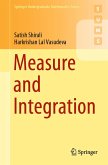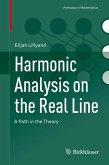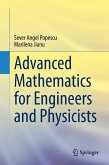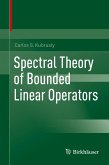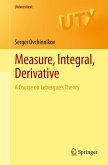Developed over years of classroom use, this textbook provides a clear and accessible approach to real analysis. This modern interpretation is based on the author's lecture notes and has been meticulously tailored to motivate students and inspire readers to explore the material, and to continue exploring even after they have finished the book. The definitions, theorems, and proofs contained within are presented with mathematical rigor, but conveyed in an accessible manner and with language and motivation meant for students who have not taken a previous course on this subject.
The text covers all of the topics essential for an introductory course, including Lebesgue measure, measurable functions, Lebesgue integrals, differentiation, absolute continuity, Banach and Hilbert spaces, and more. Throughout each chapter, challenging exercises are presented, and the end of each section includes additional problems. Such an inclusive approach creates an abundance of opportunities for readers to develop their understanding, and aids instructors as they plan their coursework. Additional resources are available online, including expanded chapters, enrichment exercises, a detailed course outline, and much more.
Introduction to Real Analysis is intended for first-year graduate students taking a first course in real analysis, as well as for instructors seeking detailed lecture material with structure and accessibility in mind. Additionally, its content is appropriate for Ph.D. students in any scientific or engineering discipline who have taken a standard upper-level undergraduate real analysis course.
The text covers all of the topics essential for an introductory course, including Lebesgue measure, measurable functions, Lebesgue integrals, differentiation, absolute continuity, Banach and Hilbert spaces, and more. Throughout each chapter, challenging exercises are presented, and the end of each section includes additional problems. Such an inclusive approach creates an abundance of opportunities for readers to develop their understanding, and aids instructors as they plan their coursework. Additional resources are available online, including expanded chapters, enrichment exercises, a detailed course outline, and much more.
Introduction to Real Analysis is intended for first-year graduate students taking a first course in real analysis, as well as for instructors seeking detailed lecture material with structure and accessibility in mind. Additionally, its content is appropriate for Ph.D. students in any scientific or engineering discipline who have taken a standard upper-level undergraduate real analysis course.
Dieser Download kann aus rechtlichen Gründen nur mit Rechnungsadresse in A, B, BG, CY, CZ, D, DK, EW, E, FIN, F, GR, HR, H, IRL, I, LT, L, LR, M, NL, PL, P, R, S, SLO, SK ausgeliefert werden.
"This book is written in a clear style that is suitable for students reading on their own or as part of a guided class. ... this book gives an accessible introduction to real analysis with emphasis on Lebesgue measure and Lebesgue integration in Euclidean spaces. This book could be suitable as a primary text for a first course focused on measure theory in Euclidean spaces or, due to the numerous exercises throughout, as a supplemental text for instructors giving other introductory measure theory courses." (Gareth Speight, Mathematical Reviews, June, 2020)
"This book is intended primarily for students beginning their graduate studies in mathematics but it will also be suitable for well-prepared undergraduates." (Frédéric Morneau-Guérin, MAA Reviews, February 16, 2020)
"The book isreally a textbook full of intermediate motivated questions addressed to the audience and step-divided discussions. It can be suitable for first-year students in mathematics, for well-prepared undergraduate mathematical majors, and for graduate students from a variety of engineering and scientific applications." (Sergei V. Rogosin, zbMATH 1426.26001, 2020)
"This book is intended primarily for students beginning their graduate studies in mathematics but it will also be suitable for well-prepared undergraduates." (Frédéric Morneau-Guérin, MAA Reviews, February 16, 2020)
"The book isreally a textbook full of intermediate motivated questions addressed to the audience and step-divided discussions. It can be suitable for first-year students in mathematics, for well-prepared undergraduate mathematical majors, and for graduate students from a variety of engineering and scientific applications." (Sergei V. Rogosin, zbMATH 1426.26001, 2020)




